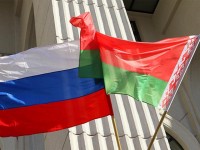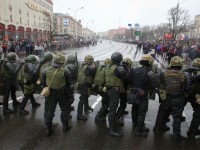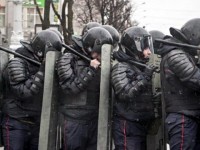Poland and Germany were both initiators and drivers of a New Eastern policy linked to the Eastern neighborhood and Russia/Soviet Union.
The potential of solidarity of the Belarusan society is vanishing

The Center for European Transformation (CET) and Belarusan Institute for Strategic Studies (BISS) continued studying the potential of solidarity — this time of the Belarusan society in general.
The empirical base for CET and BISS research is a sociological survey representative for the population of Belarus and conducted by NOVAK company in late May-early June 2015.
The research continues the one conducted by the Center for European Transformation and Belarusan Institute for Strategic Studies last year, when research into “Belarusan organized civil society’s” solidarity potential was made, i.e. solidarity among leaders and activists of NGOs and civic initiatives. Both stages are conducted with the use of similar methods in order to provide compatibility of results.
“The main aim of the research is to evaluate and interpret the potential of social and political solidarity in the Belarusan society. The important characteristic of solidary actions is their situational (one-time) nature, i.e. solidarity appears and can be secured in some concrete manifestation but not as regular occupation and work or permanent feature of this or that community, group, society,” explained Aksana Shelest, senior analyst with the Center for European Transformation to the EuroBelarus Information Service. “That’s why the object of research is the potential of solidarity, by which we understand the quality of connections and relations between people that enables us to do solidary actions in the social and political sphere and forms the basis for demonstrating solidarity.”
The research was grounded on the following “dimensions”, which can explain the potential of solidarity:
- Similarity vs. difference in perception and evaluation of significant social and political objects and potential objects of demonstrating solidarity;
- Identification and feeling as a part of a certain social group;
- The relation of trust vs. distrust to groups, people, and social institutes.
“Besides, we were trying to study and analyze a number of factors that (might) have influence on the potential of solidarity and its real demonstrations. It is communicative behavior and strategies (sources of information that people use; a field where people discuss these or that problems, agenda that concerns them, etc.); some experience of participation in any solidary, common actions, initiatives or events; mobility (both professional, working, and territorial), experience in realization of independent initiatives in business or public activity and so on,” noted Aksana Shelest.
As Andrei Yahorau, the head of the Center for European Transformation, reminded, the former research showed that the potential of solidarity inside civil society is quite low: “We can’t expect some mass solidarity from civil society, some common actions of social and political nature related to the values that seem to be shared among civil society; such as, for example, human rights — this category rather disunites the participants of the civil society than unites them and motivated for solidary actions.”
“We used the same methodology for evaluating the potential of solidarity in general. And it turned out that the Belarusan society is even more amorphous than the Belarusan civil society. It is even more divided, more atomized; it is much harder to find some clusters of potentially solidary groups in it,” said Andrei Yahorau.
According to Andrei Yahorau, “unfortunately, the research showed that there are no objects in the mass conscience of the society that would consolidate Belarusan society; mass conscience sees no guiding lines in the form of opinion leaders.”
“Of course, it presents civil society in a better light; on the other hand, if we would evaluate the potential of civil society’s solidarity as a low one, then the potential of solidarity of the Belarusan society is lower than low. We believe that this situation is related to a number of social diseases our society is going through, such as distribution of paternalism, orientation towards authorities that will resolve our problems for us, aversion of resolving problematic issues through public institutions that are designed specially for that and use of personal connections instead, which causes corruption and so on. I think that the research discloses some reasons that stand behind those social diseases that modern Belarus suffers from,” assumes Andrei Yahorau.
Alena Artsiomenka, BISS analyst, notes that “we considered person’s affiliation with certain social communities and identification with diverse groups as one of the grounds for support, mutual help, and solidarity.”
Researchers suggested the following groups:
- Communities of various scales (from primary to the largest ones: with one’s family and close friends; with inhabitants of one’s city (village); with people of the same nationality; with all people on the planet);
- Groups of social and demographic features (age, profession, sufficiency);
- Groups of national and civic identity;
- Political-ideological axiological identifications (with those who share the same beliefs and points of view; with those who share the same political positions; with those who are not interested in politics; with those who are sure that nothing depends on their actions; with those who do not wait for manna from heaven, but create their own destiny and life; with those who have not lost their faith in the future).
As it turned out, the leader as for the identification frequency is the group “With family and close friends” — 77% of respondents feel affinity with them.
Let us recall that the presentation of results of the research “The potential of solidarity of the Belarusan society” will take place on September 29 in the cultural center “Studio67” (Minsk, Partyzanski avenue, 2) from 6 to 8 p.m.
You can confirm your participation in the event as well as ask additional question by writing to [email protected].
Please also follow the news of the event on Facebook (in Russian).
Others
-
Uladzimir Matskevich: The sooner the "Union State" is denounced, the better for Belarus
Not only does the “Union State” undermine the establishment of civilized relations with Europe, but it hinders the possibility of normal relations between Belarus and Russia.
-
Uladzimir Matskevich: The regime can no longer control the situation in the country
The authorities are unable to prolong the social contract with the people: there is no way out of the social crisis.
-
Press release of the BNP in connection with the next round of the dialogue in the format of the EU-Belarus Coordination Group
Belarusan National Platform of the Eastern Partnership Civil Society Forum welcomes the dialogue process in the format of the EU-Belarus Coordination Group, the third round of which was held in Minsk on 3-4 April 2017.
-
Hennadiy Maksak: Europe must react adequately to the events in Minsk
A new wave of political repressions should make the EU return to tougher policy towards the Belarusan regime.








Comments
From farewell to a new Eastern policy and towards a new development
Poland and Germany were both initiators and drivers of a New Eastern policy linked to the Eastern neighborhood and Russia/Soviet Union.